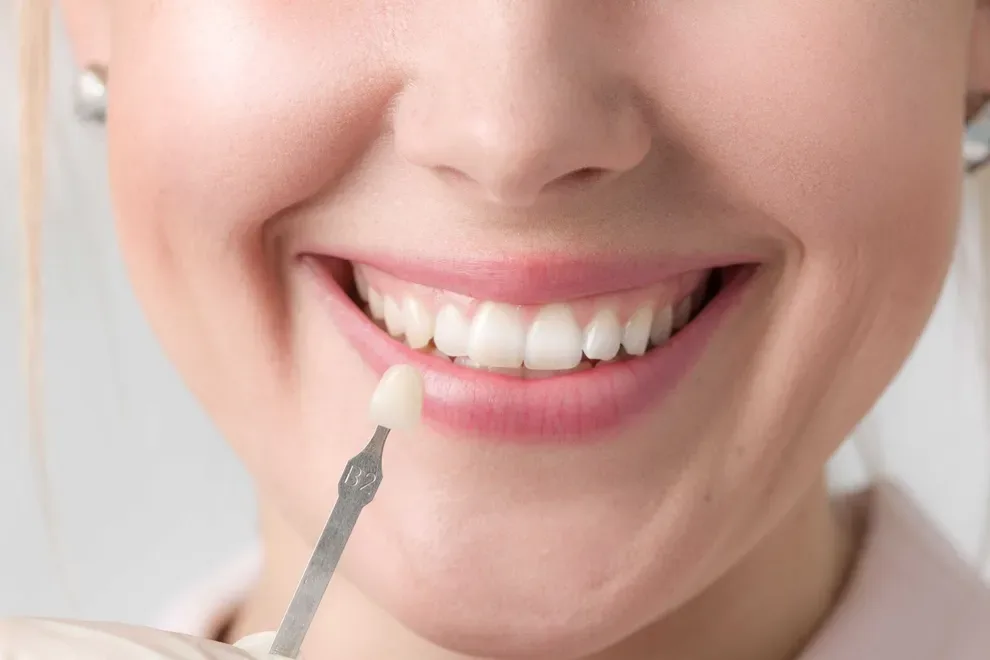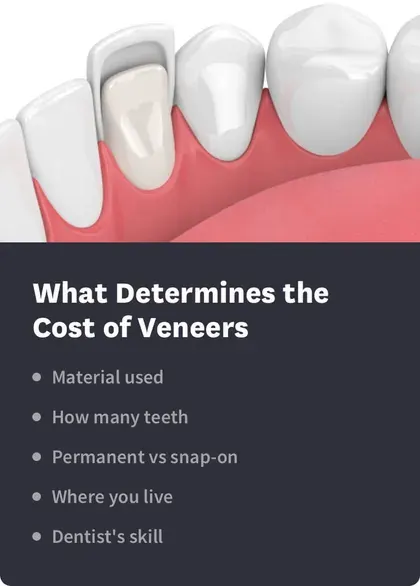Veneers Cost Guide: Types, Insurance & Comparisons

Table of Contents
- Cost of Veneers
- Unlikely Coverage for Veneers
- Snap-On Veneers
- Why Are Veneers Popular
- How the Veneer Process Works
- Specifics on Veneer Materials
- Veneers Are Not for Everyone
- One Option Among Many
It is unlikely that your dental insurance will cover the cost of veneers since they are typically cosmetic. If you need veneers for a legitimate medical reason, insurance may cover some of the cost.
How Much Do Veneers Cost?

The Consumer Guide to Dentistry found that the cost of porcelain or composite veneers can differ based on the general cost of living in your area, your dentist’s individual fees, and the artistic and technical skill of the dentist creating and placing them. Your dental insurance may cover some of the cost, but this is unlikely since many dental insurance companies consider veneers to be a cosmetic treatment.
Costs range greatly according to the materials used.
The cost is usually $925 to $2,500 per tooth. These veneers can last at least 10 years, potentially as long as 20 years, so you will not pay to replace your veneers often throughout your lifetime.
These are much more affordable for most people, with a price range of $250 to $1,500 per tooth. However, these veneers are much less durable. By the end of their life, they may not look like natural teeth.
With good care, composite veneers last five to seven years, but this means you will replace them much more often than porcelain veneers. This consistent replacement may make them more expensive over your lifetime.
When considering the cost of veneers, you should also consider the cost of the procedure to put them on your teeth. Steps in the veneer placement procedure may include:
Making an impression of your tooth.
Putting a temporary veneer on your tooth while the permanent one is being made.
Local anesthesia when your veneer is placed, but not many people need this option.
Depending on your dentist, each of the above may incur additional costs. Make sure you inquire beforehand, so you are fully aware of the total price tag before you proceed.
Insurance Coverage for Veneers Is Unlikely
It is unlikely your dental insurance will cover the cost of veneers unless there is a clear medical reason for the veneers. Most people get veneers for cosmetic reasons, which dental insurance plans typically do not cover.
You may investigate some dental plan options that could offer some financial support for veneers or other cosmetic dentistry options. For example, many dentists work with financing companies to create payment plans, so you can get cosmetic dentistry from your current dentist who knows your smile or from a professional they recommend.
Your dental insurance may also offer a health savings plan. You can begin putting money in this plan, so you can quickly save up for veneers.
On average, porcelain veneers cost between $925 to $2,500 per tooth and resin-based composite veneers are cheaper, costing between $250 and $1,500 per tooth.
Snap-On Veneers
Since permanent veneers are so expensive and not guaranteed to last forever, more people are turning to a less expensive, temporary (even, for some, removable) type of “veneer.” There are even mail-order, at-home options. You create a mold of your teeth and then send it to the company’s lab to have a custom, snap-on bridge created and mailed back to you.
Snap-on veneers are made from dental resin, and they are thin and durable. They are more comfortable for many people compared to invasive dental procedures that require shaving off some of your enamel. The typical cost of snap-on veneers, measured and placed in a dentist’s office, is between $1,000 and $3,000 for an upper or a lower arch. You may be able to find options that are $500 to $1,000 for one arch.
At-home snap-on veneers can be as inexpensive as $250 to $500 per arch.
Although this can be an appealing, short-term solution to covering stained teeth, or teeth with old chips or cracks, they are not a good option compared to other veneers. They can increase your risk of plaque and tooth decay. They are poor quality and not as durable as resin-based composite or porcelain. They may be uncomfortable as they are not as well fitted to your teeth, and they can soften when exposed to heat. You cannot consume hot food or drinks while wearing snap-on veneers.
Why Are Veneers So Popular?
Put simply, veneers look good. They consist of a thin layer of an artificial material that is the same color as a tooth, applied to the surface of your teeth to make them look brighter, straighter, or to hide chips and cracks.
Movie stars and famous musicians have used veneers to improve their smiles for a long time, but this trend is becoming more accessible to everyday people, thanks to changing materials and costs.
Your dentist may recommend using veneers in certain medical circumstances. Ask your dentist if your veneers could be considered medically necessary since your dental insurance may at least partially cover the cost. If you are interested primarily in getting straighter, whiter teeth, your dental insurance will likely not cover this treatment, but they may cover part of other options like orthodontics.
How the Veneer Process Works
Dental veneers are thin shells that are custom-made to fit your teeth and create better brightness, alignment, and tooth size. People who have damaged or stained teeth are the most common recipients of dental veneers, as this solution saves some of the enamel on your teeth from harsh whitening products and improves the overall symmetry of your teeth.
Your dentist may also recommend dental veneers to cover:
Crooked or misaligned teeth.
Gaps in your teeth.
Tooth decay.
Chips or missing pieces.
Once your veneers have been created and sized to your mouth, your dentist will shave off a small amount of enamel and place the veneer on top of that area. Although veneers may need to be replaced, they are permanent adjustments to your teeth. You cannot take them off once they have been placed.
Specifics on Veneer Materials
There are two materials used to make veneers.
This material creates a strong, thin cap that can be placed on the tops and sides of the teeth to improve their appearance. The porcelain will be designed to match the color of your teeth, but you can also ask to have them whitened since porcelain responds well to brightening agents.
There are many benefits of porcelain veneers:
They will not stain.
They are less likely to fracture or chip.
They can last 20 years.
There are also some downsides of porcelain:
They are more expensive than composite veneers.
They are more difficult to fix if they are damaged.
They require enamel removal.
These versions are less expensive than porcelain, and they require less enamel removal. In some cases, your dentist may not need to remove any enamel to place the composite veneer properly. They are also easier to replace than porcelain veneers if they are broken or damaged.
These are some of the benefits of composite veneers:
They are less expensive than porcelain.
They may not require enamel removal.
They only require one session to put in place.
They are easier to fix if damaged.
These are some of the downsides of composite:
They are not as durable as porcelain.
They may stain or crack over time.
They need to be replaced every five years, which can increase their lifetime cost.
Veneers Are Not for Everyone
Before veneers can be applied to your teeth, your dentist must give you a full exam to make sure your mouth is healthy enough for this option. They will ensure:
Your teeth and gums are healthy, even if they are stained, cracked, or slightly misaligned.
You do not clench or grind your teeth (bruxism).
You understand that some enamel will be removed from your teeth, and you will eventually need to have your veneers replaced to maintain good oral health.
You continue to brush and floss at least twice every day to keep your veneers and your natural teeth healthy.
It may take a few days to get used to the feeling of veneers in your mouth.
One Option Among Many to Improve Your Smile
Many people who are interested in veneers struggle with something they dislike about their smile and want a quick fix. Especially after years of braces or other orthodontics as children or teenagers, it is understandable that adults may be impatient to improve their smiles.
Ask your dentist if veneers are the best option for you. In some cases, a different type of correction tool, like clear aligners, might work better for improving your smile.
Veneers FAQs
The price of a full set of veneers varies, depending on what is considered a “full set.” A set of six, covering the “social six” front teeth, costs between $10,800 and $15,000. A larger set of eight veneers costs $14,400 to $20,000. The actual price varies, depending on where you live, your dentist’s skill with veneers, and other factors.
Veneers are often associated with the Hollywood smile — dazzling and bright white. Such a quick, total change in your smile has a Hollywood star’s price tag attached to it. Although many people are opting for some types of cosmetic dental procedures, it is rare for the average person to pay for a full set of veneers.
Individual veneers range in cost from as low as $925 to as much as $2,500 per tooth, according to the American Dental Association (ADA).
Composite veneers, rather than ceramic, can cost as little as $400 per tooth, but these do not last as long as porcelain veneers and will not look as natural. Although it costs more upfront, ceramic veneers last for over a decade, so they are more cost-effective.
Many people get individual veneers because they need to improve the appearance of teeth that are stained or damaged but do not need other types of dental treatment like root canals. Unlike a dental implant, a veneer does not replace a natural tooth, as it requires the presence of the tooth to stay in place.
No, veneers don’t ruin your teeth, although there are some downsides to this procedure.
Since some of the enamel must be removed from your tooth for the veneer to adhere properly, you can experience increased sensitivity to temperature. If the veneer is not properly placed, it can allow bacteria into the tooth and cause decay and gum disease. However, this is very rare with a skilled dentist.
Rather than harming your teeth, veneers can be a great option to improve your oral health by covering cracks or chips that might increase your risk of gum disease and tooth decay.
Veneers are unlikely to be covered by your dental insurance, as they are considered cosmetic. Even if you have significant dental issues like receding gums, stains, or misalignments, veneers only improve the appearance of your teeth without treating any underlying conditions. Dental insurance covers treatments to restore oral health, not cosmetic issues.
Since dental insurance will not cover the cost of veneers, there are other options you can consider. Some dental savings plans allow you to use this money to pay for cosmetic treatment, including veneers or clear plastic aligners. You may be able to work with your dentist to set up a dental loan for your treatment.
